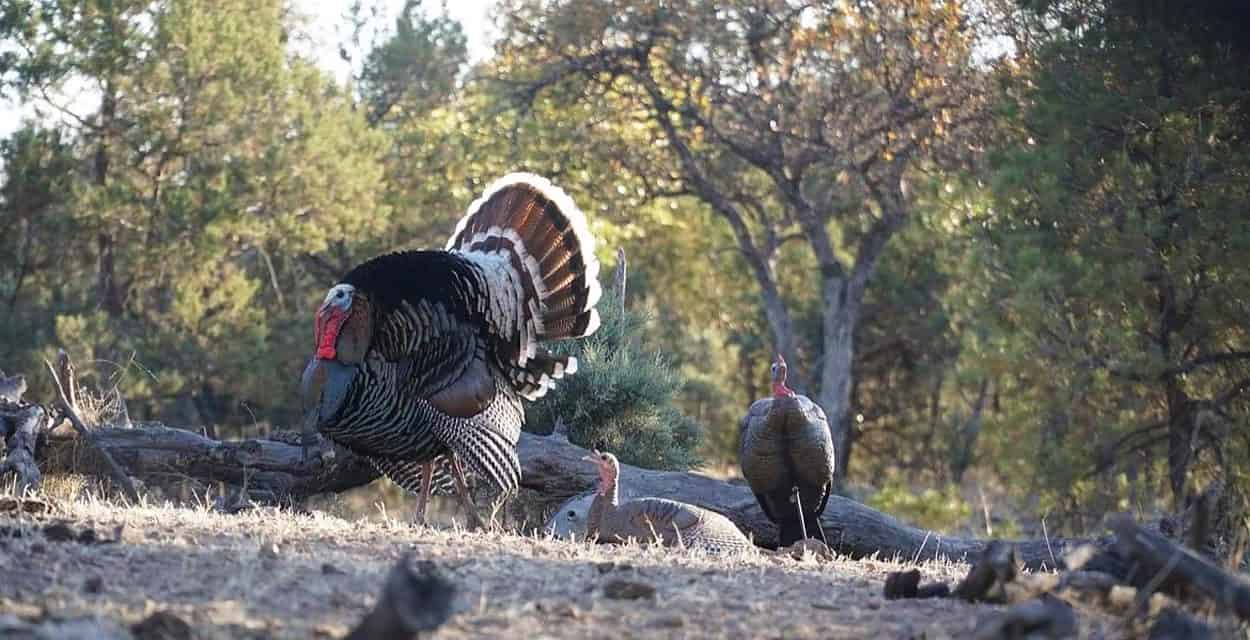By Katie DeLorenzo

Gould’s turkey hen, taken in Peloncillo Mountains, New Mexico. Photo by Mark L. Watson, terrestrial habitat specialist, New Mexico Department of Game and Fish.
New Mexico’s bootheel region is a treasure trove of unique plants and lesser-known native wildlife. With limited public access through the Coronado National Forest and other small public land parcels, the area is a bit harder to access than other national forests but worth the extra effort. The remarkably small Coues white-tailed deer, ringtail cat, white-nosed coatimundi, and Gould’s turkey (Meleagris gallopavo mexicana) all call this uniquely beautiful landscape home and contribute to its otherworldly feel.
In 1856 English ornithologist John Gould collected the first recorded specimen of the Gould’s turkey in Mexico, citing their having a taller stature and brilliant white tail-feather tips that set them apart from other subspecies. New Mexico is home to three of six wild turkey subspecies, including the Gould’s, Merriam’s, and Rio Grande, with the Gould’s being the least abundant.
The Gould’s habitat range is incredibly unique. Most of its home range is in Mexico, with only a small range in the Sky Islands region of the United States that spans the borderlands of Arizona, Mexico, and southwestern New Mexico. The Gould’s primary habitat in New Mexico is the Peloncillo Mountains. While the Animas and San Luis Mountains also have presumed small populations, private ownership has restricted research access. In 1974, due to limited habitat range and an unknown population status, the Gould’s turkey was listed as a state threatened species under the New Mexico Wildlife Conservation Act.
Since then, research has ramped up: New Mexico State University researchers studied the birds’ diet, range, and habitat use in the Peloncillos from 1982 to 1992, and the New Mexico Department of Game and Fish and the National Wild Turkey Federation have executed annual population surveys since 2006. In 2017, a Gould’s Turkey Recovery Plan was developed and it established clear parameters to “ensure the long-term persistence of Gould’s turkey within its historical range in New Mexico.”

Left: A strutting gobbler shows off his brilliant white tail-feather tips in hopes of impressing a hen. Photo by Jay Scott and Kade Purser of Gouldsturkeyhunt.com.
Wild turkeys are an underappreciated native species, thanks in large part to the abundance of their domestic counterparts on the grocery store shelf. But, unlike the domestic turkey, the Gould’s wild turkey is highly adaptable and resourceful in a harsh environment. In 2018 the New Mexico Department of Game and Fish began an ongoing telemetry study that is revealing the incredible aptitude of this large game bird to thrive in the desert mountain ranges of the Sky Island region.
By capturing and then tagging birds with GPS transmitters, Game and Fish biologists accumulate location data points to paint a picture of where and when these birds are moving. The transmitters ping one location every night and three locations every other day, and are operable for about two and a half years. This year, twenty-five birds were outfitted with longer-lasting transmitters, although these intelligent birds are now becoming wary of being lured into the feeders where they are caught and tagged.
The current tagging program has collected more than sixty thousand location points. With this data set, biologists have reviewed the bird’s range and primary areas of use to determine which habitats the Gould’s prefers for roosting, nesting, brooding, and feeding. In the 1980s it was believed that the Chihuahua pine was the Gould’s main roost structure, and most population surveys focused on these sites. However, new data shows that the birds prefer to roost in oak and cottonwood trees. The telemetry study is also helping to pinpoint the habitat types where Gould’s turkeys are foraging for the insects, grass seeds, and fruit from trees and shrubs that they rely on for sustenance.
In addition, when starting this research, biologists didn’t know the extent of the Gould’s range north or south in New Mexico. Evidence now shows that some birds are moving as far as fifteen to twenty miles across the border into Mexico. The intermingling of birds across the border means a more rigorous genetic pool and better long-term viability for the species, assuming (and hoping) that habitat connectivity is maintained in the future.
These insights and other scientific findings enable biologists to more effectively estimate populations and execute habitat conservation and enhancement work. The Gould’s is doing so well that biologists recently recommended that the subspecies be delisted from the state’s threatened and endangered species list. For the last three years, population counts have estimated at least 200 birds—25 more than the sustaining population of 175 birds set as an objective by the recovery plan. Other pre-identified threats to Gould’s recovery, like potential hybridization with domestic turkeys, have been mitigated. While domestic turkeys may have been present in the New Mexico Gould’s habitat range in the late 1980s, no nearby private landowners are currently raising domestic turkeys.
Biologists’ evaluations of the Gould’s, measured according to predetermined goals and potential threats from the 2017 plan, have been compiled into the Gould’s Wild Turkey Delisting Investigation Report that is currently available on the New Mexico Game and Fish website. While wildlife management decisions should be guided by science and the opinions of dedicated professional biologists, wildlife is a sacred public trust. Everyday New Mexicans are encouraged to take part in the game commission process by reading the report and providing comment by September 18, 2022.

Left: A male Gould’s harvest by conservationist and Backcountry Hunters & Anglers volunteer D.J. Zor with a traditional bow in Arizona. Photo by D.J. Zor.
Speaking about the Gould’s recovery and the recommendation to delist, Casey Cardinal, resident game bird biologist for the Department of Game and Fish, says, “Through the research we’ve conducted over the last few years, we’ve gained so much information on [the] Gould’s turkey population status, habitat use, and genetic connectivity. Evaluating a population like we’ve done here is a financial and labor-intensive process, but the department is highly supportive of this type of research. With what we know now, we feel confident that Gould’s turkeys will persist into the future in New Mexico.”
Hunting and fishing license sales provide roughly $20 million annually to fund Game and Fish operations, which receive no money from New Mexico’s General Fund. This operating budget, supplemented with federal funds from the Federal Aid in Wildlife Restoration Act that matches every state dollar invested at a 3:1 ratio, are key to the recovery of the Gould’s and many other species. These dollars fund department operations including retaining qualified and passionate biologists and paying for their research. In addition, two enhancement hunting tags raise money to exclusively benefit Gould’s wild turkey management. One tag is raffled off by the local National Wild Turkey Federation chapter and the other is auctioned off at the federation’s annual convention. Due to their scarcity, highly coveted auction tags for the New Mexico Gould’s have raised up to $6,000 apiece for conservation.
Should the Gould’s be delisted, it would be managed as a protected species. A small number of once-in-a-lifetime hunting tags may be made available to hunters, giving them a chance to harvest this uniquely Southwestern bird. While most will likely never have the chance to pursue a New Mexico Gould’s, hunters remain deeply invested in the proliferation of all turkeys that call our state home. Every spring, my family and many others take part in the tradition of spring turkey hunting. If we’re lucky, we are able to enjoy several meals from each bird. There are many preparations we enjoy, but simply pounding out the breasts, breading, and frying them is one of our favorites. In addition to using the meat, my dad often crafts turkey calls from the wing bones and inscribes our names on them as keepsakes. These tangible tokens of our hunt are incredibly valuable, but the real gift is knowing that these birds, with their cunning senses and thunderous gobbles, will enliven the landscape for generations to come.
With a little planning and time, you can visit this remote corner of the state to experience the stark beauty of the desert Southwest and the distinctive Gould’s turkey firsthand. Interested readers can reach out to me for more information at newmexicohuntress@gmail.com.

Katie DeLorenzo
A hunter, conservationist, passionate home cook, and the western regional manager for conservation group Backcountry Hunters & Anglers, Katie DeLorenzo’s free time is spent exploring our wild public lands and waters, mentoring new hunters, and sharing the gospel of an outdoor lifestyle.







